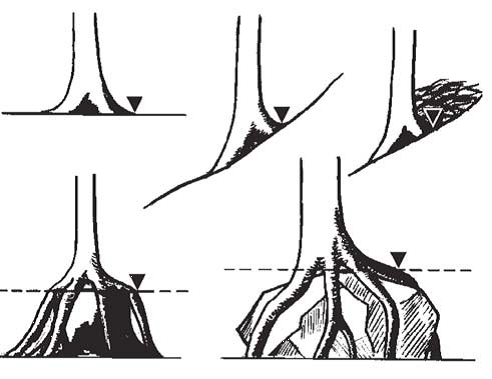308 Diameter at breast height [dbh]
Definition
The diameter at breast height [dbh] (1.3 m height from ground level) of all trees in the plots/sub-plots with a diameter of 5.0 cm over bark (and of all shoots with a diameter of 3.0 cm over bark in coppices) or greater must be measured every five years.
Methods
-
Diameters are to be measured perpendicular to the longitudinal axis of the stem (i.e. at an angle on leaning trees).
-
Lichens and loose debris are to be removed prior to the measurement.
-
Measurements are not be made under frosty conditions, because tree stems shrink substantially.
-
Measurements are to be made using a diameter tape or a calliper of similar accuracy, and are to be recorded to the nearest 0.1 cm.
-
The point(s) of measurement are to be clearly marked on the tree.
-
Two points being necessary when using callipers at which the maximum diameter is measured and a second point at right-angles to this.

Definition of ground level under different conditions
Forked trees, with the fork below 1.3 m, are to be treated as two separate trees (problems may arise if these trees will unify after a while).
Coppice shoots originating from a single stool are to be treated as separate trees (e.g. stool 123, shoots 1,2,3, …; stool 124, shoots 1,2,…).
If there is an irregularity at 1.3 m, diameter measurements are to be taken at points above and below the irregularity and the averaged value is to be reported.
Trees with root buttresses above ground level are to have their diameters measured 1.3 m above the ground on the upper side of the tree.
If the tree shows important irregularities at 1.3 m two diameters one below 1.3 and the other at the same distance above should measured and the average reported.

Where to measure dbh on trees with different form